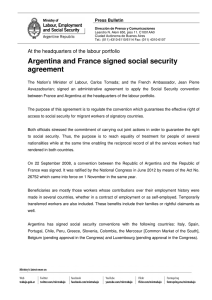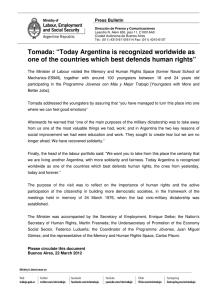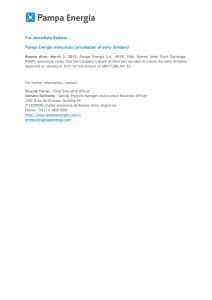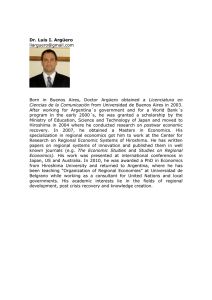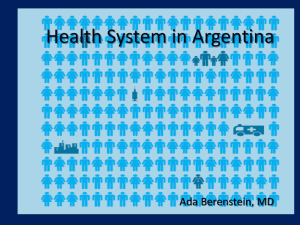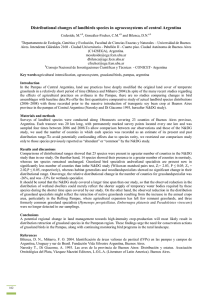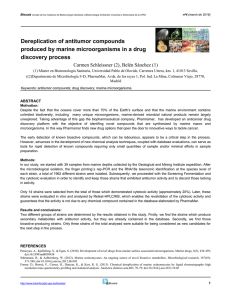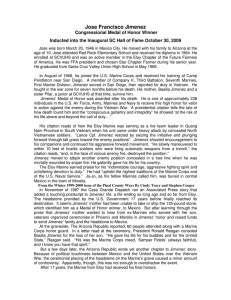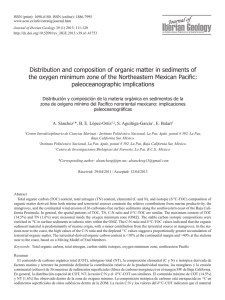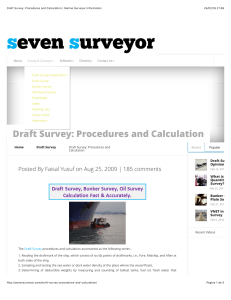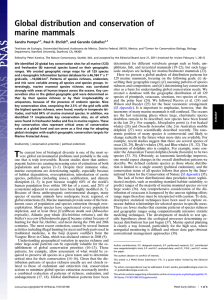Marine Sediments Attributed to Marine Isotope Stage 3 in the
Anuncio
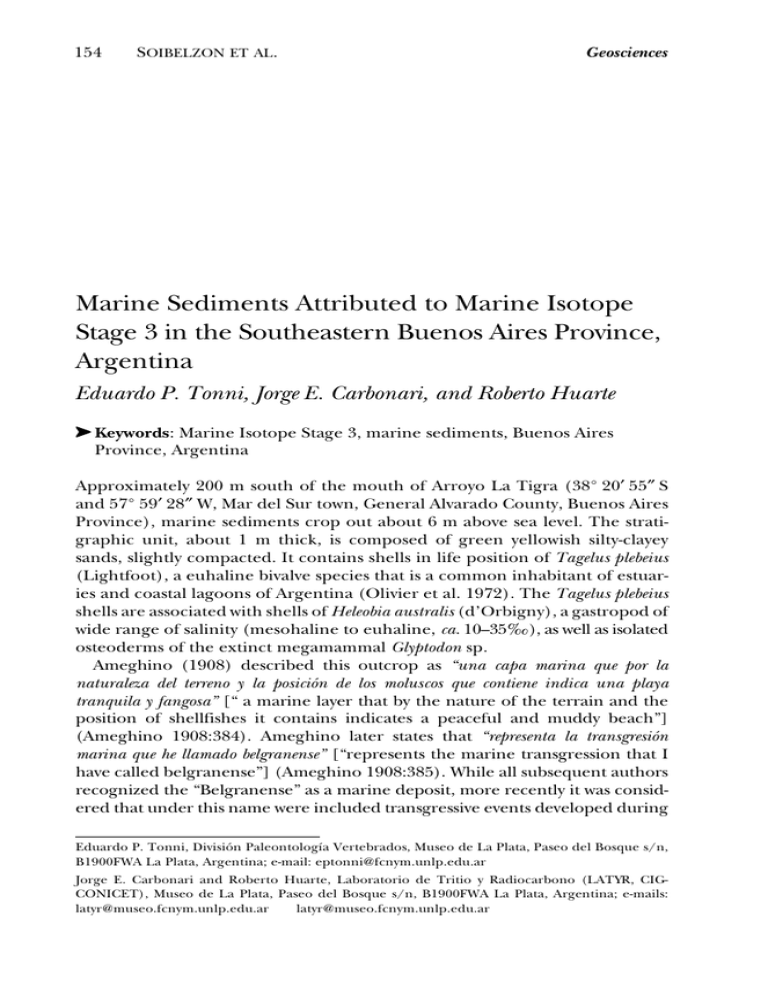
154 SOIBELZON ET AL. Geosciences Marine Sediments Attributed to Marine Isotope Stage 3 in the Southeastern Buenos Aires Province, Argentina Eduardo P. Tonni, Jorge E. Carbonari, and Roberto Huarte ➤ Keywords: Marine Isotope Stage 3, marine sediments, Buenos Aires Province, Argentina Approximately 200 m south of the mouth of Arroyo La Tigra (38° 20′ 55″ S and 57° 59′ 28″ W, Mar del Sur town, General Alvarado County, Buenos Aires Province), marine sediments crop out about 6 m above sea level. The stratigraphic unit, about 1 m thick, is composed of green yellowish silty-clayey sands, slightly compacted. It contains shells in life position of Tagelus plebeius (Lightfoot), a euhaline bivalve species that is a common inhabitant of estuaries and coastal lagoons of Argentina (Olivier et al. 1972). The Tagelus plebeius shells are associated with shells of Heleobia australis (d’Orbigny), a gastropod of wide range of salinity (mesohaline to euhaline, ca. 10–35‰), as well as isolated osteoderms of the extinct megamammal Glyptodon sp. Ameghino (1908) described this outcrop as “una capa marina que por la naturaleza del terreno y la posición de los moluscos que contiene indica una playa tranquila y fangosa” [“ a marine layer that by the nature of the terrain and the position of shellfishes it contains indicates a peaceful and muddy beach”] (Ameghino 1908:384). Ameghino later states that “representa la transgresión marina que he llamado belgranense” [“represents the marine transgression that I have called belgranense”] (Ameghino 1908:385). While all subsequent authors recognized the “Belgranense” as a marine deposit, more recently it was considered that under this name were included transgressive events developed during Eduardo P. Tonni, División Paleontología Vertebrados, Museo de La Plata, Paseo del Bosque s/n, B1900FWA La Plata, Argentina; e-mail: eptonni@fcnym.unlp.edu.ar Jorge E. Carbonari and Roberto Huarte, Laboratorio de Tritio y Radiocarbono (LATYR, CIGCONICET), Museo de La Plata, Paseo del Bosque s/n, B1900FWA La Plata, Argentina; e-mails: latyr@museo.fcnym.unlp.edu.ar latyr@museo.fcnym.unlp.edu.ar CRP 27, 2010 TONNI ET AL. 155 different warm episodes of the Pleistocene (e.g., Marine Isotope Stage (MIS) 11 and MIS 5e; see Cione et al. 2002; Pardiñas et al. 1996, Verzi et al. 2004). In Mar del Sur two samples of shells of Tagelus plebeius were obtained for radiocarbon dating. Sample LP-2124 gave a conventional radiocarbon age of 25,700 ± 800 RCYBP, corrected by δ13C at 0 ± 2 . This sample is stratigraphically about 30 cm above sample LP-1757, which gave a conventional radiocarbon age of 33,780 ± 1200 RCYBP, also corrected for δ13C at 0 ± 2 . This radiocarbon period corresponds to the end of MIS 3. During MIS 3 there were abrupt warmings in the Northern Hemisphere (DansgaardOeschger events; see Huber et al. 2006; Van Meerbeeck et al. 2008), which were also manifested in the Southern Hemisphere (Bae et al. 2003). Hodgson et al. (2009) described East Antarctica marine sediments at 8 m.a.s.l. According to radiocarbon dates these sediments were attributed to a rise in sea level that was developed in the radiocarbon period 26,650 ± 220 and 28,750 ± 300 RCYBP (i.e., the end of MIS 3). Previously, Cortelezzi (1977), Weiler et al. (1987), González and Ravizza (1987), and Weiler and González (1988) described coastal marine sediments in Buenos Aires Province attributed to the last Interstadial between 25,000–38,000 RCYBP. Rabassa (1983) described beach marine sediments from the Antarctic Peninsula considered to be isostatically raised and attributed to a partial glacier recession. Shells of the mollusk Laternula elliptica (King and Boderip) found in life position gave an age of 34,115 ± 1110 RCYBP (Hv-11002), which also corresponds to the end of MIS 3. Martinez et al. (2001) described marine sediments in Puerto de Nueva Palmira (Colonia County, Uruguay, 33° 52′ S - 58° 25′ W) and provided radiocarbon dates. These dates were from shells of Mactra isabelleana (d’Orbigny) (31,000 ± 1,200 RCYBP; LP-738) and Anomalocardia brasiliana (Gmelin) (34,600 ± 2000 RCYBP; LP-730). The dated shells of Anomalocardia brasiliana had a 100% aragonitic composition, which are discarded alterations that may have affected the age obtained. In Mactra isabelleana, the composition is equally (50%) calcite and aragonite. According to Kennedy et al. (1969), the Mactridae have completely aragonitic shells, so the sample LP-738 has been affected, but this does not seem to have influenced the age obtained. In this case it is possible that it had been a partial crystallographic conversion of aragonite/calcite, and not a replacement of calcite of different ages. However, Martinez et al. (2001) consider these radiocarbon dates as minimum ages, concluding that the transgression which gave origin to the deposit must be correlated with the last interglacial (MIS 5e). From our point of view, however, these ages are finite, statistically distinguishable from the dating limit of the method. Consequently, they represent an event that occurred near the end of MIS 3 and not during MIS 5e. The dates reported here for marine sediments of Mar del Sur provide new evidence about the abrupt warming that occurred during MIS 3, causing rising sea levels, probably not significant but still geologically expressed. The authors thank Agencia Nacional de Promoción Científica y Tecnológica, Comisión de Investigaciones Científicas de la Provincia de Buenos Aires, Consejo Nacional de Investigaciones Científicas y Técnicas, and Universidad Nacional de La Plata for financial support. 156 TONNI ET AL. Geosciences References Cited Ameghino, F. 1908 Las Formaciones Sedimentarias de la Región litoral de Mar del Plata y Chapalmalan. Anales del Museo Nacional de Buenos Aires 10:343–428. Bae, S. H., H. I. Yoon, B-K. Park, Y. Kim, J. Bahk, and J. H. S. Seo 2003 Meltwater Discharge Anomalies in Marine Isotope Stage 3 from a Sediment Core in the South of Antarctic Polar Front, Drake Passage. Geosciences Journal 7(1):1–88. Cione, A. L., E. P. Tonni, and J. O. San Cristóbal 2002 Middle Pleistocene Marine Transgression in Central-Eastern Argentina. Current Research in the Pleistocene 19:16–18. Cortelezzi, C. 1977 Datación de las Formaciones Marinas en el Cuaternario de las Proximidades de La Plata-Magdalena, Provincia de Buenos Aires. LEMIT, Anales 1. La Plata. González, M., and G. Ravizza 1987 Sedimentos Estuáricos del Pleistoceno Tardío y Holoceno en la Isla Martín García (Río de la Plata, República Argentina). Revista de la Asociación Geológica Argentina 42(3-4):231–43. Hodgson, D., E. Verleyen, W. Vyverman, K. Sabbe, M. J. Leng, M. D. Pickering, and B. J. Keely 2009 A Geological Constraint on Relative Sea Level in Marine Isotope Stage 3 in the Larsemann Hills, Lambert Glacier Region, East Antarctica (31 366–33 228 cal yr BP). Quaternary Science Reviews, 28 (25–26):2689–96. Huber, C., M. Leuenberger, R. Spahni, J. Flückiger, J. Schwander,T. F. Stocker, S. Johnsen, A. Landais, and J. Jouzel 2006 Isotope Calibrated Greenland Temperature Record over Marine Isotope Stage 3 and Its Relation to CH4. Earth and Planetary Science Letters 243:504–19. Kennedy, W. J., J. D. Taylor, and A. Hall 1969 Environmental and Biological Controls on Bivalve Shell Mineralogy. Biological Reviews 44:499–530. Martinez, S., M. Ubilla, M. Verde, D. Perea, A. Rojas, R. Guérequiz, and G. Piñeiro 2001 Paleoecology and Geochronology of Uruguayan Coastal Marine Pleistocene Deposits. Quaternary Research 55:246–54. Olivier, S. R., A. M. Escofet, P. Penchazadeh, and J. M. Orenzans 1972 Estudios Ecológicos de la Región Estuarial de Mar Chiquita (Buenos Aires, Argentina). I. Comunidades Bentónicas. Anales de la Sociedad Científica Argentina 193:237–62. Pardiñas, U. F. J., J. Gelfo, J. San Cristóbal, A. L. Cione, and E. P. Tonni 1996 Una Asociación de Organismos Marinos y Continentales en el Pleistoceno Superior en el Sur de la Provincia de Buenos Aires, Argentina. Actas XIII Congreso Geológico Argentino y III Congreso de Exploración de Hidrocarburos 5:95–112. Rabassa, J. 1983 Stratigraphy of the Glacigenic Deposits in Northern James Ross Island, Antarctic Peninsula. In Till and Related Deposits, edited by E. B. Evenson, C. Schlüchter, and J. Rabassa, A. A. Balkema Publ., pp. 324–40. Van Meerbeeck, C. J., H. Renssen, and D. M. Roche 2008 How did Marine Isotope Stage 3 and Last Glacial Maximum Climates Differ? Perspectives from Equilibrium Simulations. Climate of the Past Discussions 4(5):1115–58. Verzi, D., C. M. Deschamps, and E. P. Tonni 2004 Biostratigraphic and Palaeoclimatic Meaning of the Middle Pleistocene South American Rodent Ctenomys kraglievichi (Caviomorpha, Octodontidae). Palaeogeography, Palaeoclimatology, Palaeoecology 212:315–29. Weiler, N., M. González and N. Guida 1987 Niveles Marinos del Pleistoceno Tardío en Cañada de Arregui, Partido de Magdalena, Provincia de Buenos Aires. Revista de la Asociación Geológica Argentina, 41(1-2):92–98 Weiler, N and M. González 1988 Evidencias Paleoeustáticas del Pleistoceno Tardío y Holoceno en Laguna de Sotelo (Provincia de Buenos Aires) y Regiones Adyacentes Durante el Pleistoceno Tardío y Holoceno. Revista de la Asociación Geológica Argentina 43(4):529–43.
